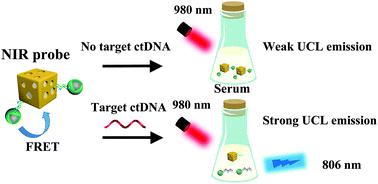Our official English website, www.x-mol.net, welcomes your
feedback! (Note: you will need to create a separate account there.)
Upconversion nanoparticle and gold nanocage satellite assemblies for sensitive ctDNA detection in serum.
Analyst ( IF 3.6 ) Pub Date : 2020-06-11 , DOI: 10.1039/d0an00701c Jiawei Wang 1 , Guanping Hua , Lihuang Li , Danyang Li , Fanfan Wang , Jiazhen Wu , Ziyue Ye , Xi Zhou , Shefang Ye , Jun Yang , Xinjie Zhang , Lei Ren
Analyst ( IF 3.6 ) Pub Date : 2020-06-11 , DOI: 10.1039/d0an00701c Jiawei Wang 1 , Guanping Hua , Lihuang Li , Danyang Li , Fanfan Wang , Jiazhen Wu , Ziyue Ye , Xi Zhou , Shefang Ye , Jun Yang , Xinjie Zhang , Lei Ren
Affiliation

|
A rapid molecular diagnostic technique targeting circulating tumor DNA (ctDNA) has become one of the most clinically significant liquid biopsy methods for non-invasive and timely diagnosis of cancer. Herein, a sensitive detection system of ctDNA based on a fluorescence resonance energy transfer (FRET) system using upconversion nanoparticles (UCNPs) and gold nanocages (AuNCs) was constructed. Through the doping of Yb and Tm ions, the excitation and emission wavelengths of UCNPs were adjusted to 980 nm and 806 nm, respectively. Subsequently, UCNPs and AuNCs with the corresponding wavelength absorption were linked by complementary pairing of surface-modified DNA to form near-infrared fluorescent nanoprobes (NIR probes). Targeting DNA mutation recognition and signal transduction were realized by using NIR probes through the toehold-mediated strand displacement reaction. This method could detect a single point mutation of the KRAS gene with a wide detection range from 5 pM to 1000 pM and the limit of detection reached 6.30 pM. More importantly, the stable and highly specific NIR probes could be directly used in the serum environment without complicated pretreatment and amplification processes in advance. It could be envisioned that this specific and sensitive ctDNA detection strategy has great potential in clinical diagnosis and monitoring of diverse malignant tumors.
中文翻译:

上转换纳米颗粒和金纳米笼卫星组件,用于血清中敏感的ctDNA检测。
针对循环肿瘤DNA(ctDNA)的快速分子诊断技术已成为临床上最重要的非侵入性及时诊断癌症的液体活检方法之一。在此,构建了使用上转换纳米颗粒(UCNPs)和金纳米笼(AuNCs)的基于荧光共振能量转移(FRET)系统的ctDNA灵敏检测系统。通过掺杂Yb和Tm离子,UCNPs的激发和发射波长分别调整为980 nm和806 nm。随后,具有相应波长吸收的UCNP和AuNC通过表面修饰的DNA的互补配对连接起来,形成近红外荧光纳米探针(NIR探针)。通过NIR探针通过脚趾介导的链置换反应实现了靶向DNA突变的识别和信号转导。该方法可以检测KRAS基因的单点突变,检测范围从5 pM到1000 pM,检测限达到6.30 pM。更重要的是,稳定且高度特异性的NIR探针可直接用于血清环境,而无需事先进行复杂的预处理和扩增过程。可以预见,这种特异性和敏感的ctDNA检测策略在各种恶性肿瘤的临床诊断和监测中具有巨大的潜力。稳定,高特异性的近红外探针可直接在血清环境中使用,无需事先进行复杂的预处理和扩增过程。可以预见,这种特异性和敏感的ctDNA检测策略在各种恶性肿瘤的临床诊断和监测中具有巨大的潜力。稳定,高特异性的近红外探针可直接在血清环境中使用,无需事先进行复杂的预处理和扩增过程。可以预见,这种特异性和敏感的ctDNA检测策略在各种恶性肿瘤的临床诊断和监测中具有巨大的潜力。
更新日期:2020-08-10
中文翻译:

上转换纳米颗粒和金纳米笼卫星组件,用于血清中敏感的ctDNA检测。
针对循环肿瘤DNA(ctDNA)的快速分子诊断技术已成为临床上最重要的非侵入性及时诊断癌症的液体活检方法之一。在此,构建了使用上转换纳米颗粒(UCNPs)和金纳米笼(AuNCs)的基于荧光共振能量转移(FRET)系统的ctDNA灵敏检测系统。通过掺杂Yb和Tm离子,UCNPs的激发和发射波长分别调整为980 nm和806 nm。随后,具有相应波长吸收的UCNP和AuNC通过表面修饰的DNA的互补配对连接起来,形成近红外荧光纳米探针(NIR探针)。通过NIR探针通过脚趾介导的链置换反应实现了靶向DNA突变的识别和信号转导。该方法可以检测KRAS基因的单点突变,检测范围从5 pM到1000 pM,检测限达到6.30 pM。更重要的是,稳定且高度特异性的NIR探针可直接用于血清环境,而无需事先进行复杂的预处理和扩增过程。可以预见,这种特异性和敏感的ctDNA检测策略在各种恶性肿瘤的临床诊断和监测中具有巨大的潜力。稳定,高特异性的近红外探针可直接在血清环境中使用,无需事先进行复杂的预处理和扩增过程。可以预见,这种特异性和敏感的ctDNA检测策略在各种恶性肿瘤的临床诊断和监测中具有巨大的潜力。稳定,高特异性的近红外探针可直接在血清环境中使用,无需事先进行复杂的预处理和扩增过程。可以预见,这种特异性和敏感的ctDNA检测策略在各种恶性肿瘤的临床诊断和监测中具有巨大的潜力。











































 京公网安备 11010802027423号
京公网安备 11010802027423号